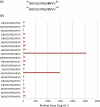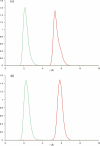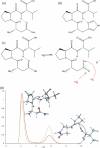Antibody recognition of a human chorionic gonadotropin epitope (hCGbeta66-80) depends on local structure retained in the free peptide
- PMID: 21592960
- PMCID: PMC3137075
- DOI: 10.1074/jbc.M111.246637
Antibody recognition of a human chorionic gonadotropin epitope (hCGbeta66-80) depends on local structure retained in the free peptide
Abstract
Human chorionic gonadotropin (hCG) is an important biomarker in pregnancy and oncology, where it is routinely detected and quantified by specific immunoassays. Intelligent epitope selection is essential to achieving the required assay performance. We present binding affinity measurements demonstrating that a typical β3-loop-specific monoclonal antibody (8G5) is highly selective in competitive immunoassays and distinguishes between hCGβ(66-80) and the closely related luteinizing hormone (LH) fragment LHβ(86-100), which differ only by a single amino acid residue. A combination of optical spectroscopic measurements and atomistic computer simulations on these free peptides reveals differences in turn type stabilized by specific hydrogen bonding motifs. We propose that these structural differences are the basis for the observed selectivity in the full protein.
Figures










Similar articles
-
The ISOBM TD-7 Workshop on hCG and related molecules. Towards user-oriented standardization of pregnancy and tumor diagnosis: assignment of epitopes to the three-dimensional structure of diagnostically and commercially relevant monoclonal antibodies directed against human chorionic gonadotropin and derivatives.Tumour Biol. 2002 Jan-Feb;23(1):1-38. doi: 10.1159/000048686. Tumour Biol. 2002. PMID: 11893904
-
Epitope analysis and detection of human chorionic gonadotropin (hCG) variants by monoclonal antibodies and mass spectrometry.Tumour Biol. 2014 Feb;35(2):1013-22. doi: 10.1007/s13277-013-1135-y. Epub 2013 Sep 7. Tumour Biol. 2014. PMID: 24014048
-
Characterization of monoclonal antibodies recognizing alpha and beta subunits of human chorionic gonadotropin hormone.Asian Pac J Allergy Immunol. 1998 Jun-Sep;16(2-3):127-35. Asian Pac J Allergy Immunol. 1998. PMID: 9876951
-
Standardization of Epitopes for Human Chorionic Gonadotropin (hCG) Immunoassays.Curr Med Chem. 2016;23(30):3481-3494. doi: 10.2174/0929867323666160530145503. Curr Med Chem. 2016. PMID: 27237818 Review.
-
Immunoassay of human chorionic gonadotropin, its free subunits, and metabolites.Clin Chem. 1997 Dec;43(12):2233-43. Clin Chem. 1997. PMID: 9439438 Review.
Cited by
-
A Point-of-Care Immunosensor for Human Chorionic Gonadotropin in Clinical Urine Samples Using a Cuneated Polysilicon Nanogap Lab-on-Chip.PLoS One. 2015 Sep 14;10(9):e0137891. doi: 10.1371/journal.pone.0137891. eCollection 2015. PLoS One. 2015. PMID: 26368287 Free PMC article.
-
Safety Implications of Off-Label Medication Use in Athletes: A Narrative Review.Medicines (Basel). 2024 Nov 15;11(8):20. doi: 10.3390/medicines11080020. Medicines (Basel). 2024. PMID: 39584970 Free PMC article. Review.
References
-
- Lapthorn A. J., Harris D. C., Littlejohn A., Lustbader J. W., Canfield R. E., Machin K. J., Morgan F. J., Isaacs N. W. (1994) Nature 369, 455–461 - PubMed
-
- Cole L. A. (2007) Placenta 28, 977–986 - PubMed
-
- O'Connor J. F., Birken S., Lustbader J. W., Krichevsky A., Chen Y., Canfield R. E. (1994) Endocr. Rev. 15, 650–683 - PubMed
-
- Sturgeon C. M., McAllister E. J. (1998) Ann. Clin. Biochem. 35, 460–491 - PubMed
-
- Gronowski A. M., Grenache D. G. (2009) Clin. Chem. 55, 1447–1449 - PubMed
Publication types
MeSH terms
Substances
LinkOut - more resources
Full Text Sources
Other Literature Sources

